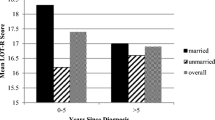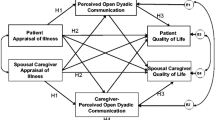Abstract
The interaction of optimism, hopelessness and social support as predictors of Health-Related Quality of Life (HRQL) among seriously ill people is not well understood. Also, the impact of partner characteristics on patient quality of life has often been overlooked. In this study the relationships between optimism, hopelessness, partner support and HRQL were investigated in 155 cancer patients and their partners. Special attention was given to the effects of optimism and hopelessness as mediators and moderators in the partner support–HRQL relationship. The impact of partner optimism and hopelessness on perceived partner support and patient HRQL was also studied. The results indicated substantial gender differences in the relationships between the study variables. High levels of partner support were associated with female patients’ optimistic appraisals, and together they predicted better HRQL at 8 months follow-up. Partial support was found for the effect of optimism as a mediator. For male patients, low hopelessness was the key variable predicting good HRQL. Clear evidence for the moderator effects of optimism/hopelessness was not found, and the expected impact of partner’s characteristics on partner support or patient HRQL could not be confirmed. Although partner support, patient optimism and hopelessness all appeared to be important determinants of HRQL in cancer patients, the relationships between these variables differed by gender. The proposed mediation and moderation models needs to be confirmed in future studies.
Similar content being viewed by others
Abbreviations
- HRQL:
-
Health-Related Quality of Life
- MCS:
-
mental component summary
- PCS:
-
physical component summary
References
White CA, Macleod U (2002) Cancer. BMJ 325(7360): 377–380
Northouse LL, Mood D, Templin T, Mellon S, George T (2000) Couples’ patterns of adjustment to colon cancer. Soc Sci Med 50(2):271–284
Northouse LL, Mood D, Kershaw T, et al (2002) Quality of life of women with recurrent breast cancer and their family members. J Clin Oncol 20(19):4050–4064
Schroeder KEE, Schwarzer R (2001) Do partners’ personality resources add to the prediction of patients’ coping and quality of life? Psychol Health 16(2):139–159
Schou I, Ekeberg O, Ruland CM (2005) The mediating role of appraisal and coping in the relationship between optimism–pessimism and quality of life. Psychooncology 14(9):718–727
Lazarus RS, Folkman S (1984) Stress, Appraisal, and Coping. Springer, New York
Scheier MF, Matthews KA, Owens JF, et al (1989) Dispositional optimism and recovery from coronary artery bypass surgery: The beneficial effects on physical and psychological well-being. J Pers Soc Psychol 57(6):1024–1040
Taylor SE, Armor DA (1996) Positive illusions and coping with adversity. J Pers 64(4):873–898
Carver CS, Pozo-Kaderman C, Harris SD, et al (1994) Optimism versus pessimism predicts the quality of women’s adjustment to early stage breast cancer. Cancer 73(4):1213–1220
Carver CS, Pozo C, Harris SD, et al (1993) How coping mediates the effect of optimism on distress: A study of women with early stage breast cancer. J Pers Soc Psychol. 65(2):375–390
Scheier MF, Carver CS, Bridges MW. Optimism, pessimism, and psychological well-being. In: Chang E (ed) Optimism and Pessimism: Implications for Theory, Research, and Practice, 1st ed. American Psychology Association, Washington, 2001: 127–145
Schou I, Ekeberg O, Ruland CM, Sandvik L, Karesen R (2004) Pessimism as a predictor of emotional morbidity one year following breast cancer surgery. Psychooncology 13(5):309–320
Trunzo JJ, Pinto BM (2003) Social support as a mediator of optimism and distress in breast cancer survivors. J Cons Clin Psychol 71(4):805–811
Epping-Jordan JE, Compas BE, Osowiecki DM, et al (1999) Psychological adjustment in breast cancer: Processes of emotional distress. Health Psychol 18(4):315–326
Allison PJ, Guichard C, Gilain L (2000) A prospective investigation of dispositional optimism as a predictor of health-related quality of life in head and neck cancer patients.Qual Life Res 9(8):951–960
Snyder CR, Sympson SC, Michael ST, Cheavens J. Optimism and hope constructs: Variants on a positive expectancy theme. In: Chang E (ed), Optimism and Pessimism; Implications for Theory and Practice, 1st ed. American Psychology Association, Washington, 2001: 101–123
Everson SA, Goldberg DE, Kaplan GA, et al (1996) Hopelessness and risk of mortality and incidence of myocardial infarction and cancer. Psychosom Med 58(2):113–121
Watson M, Haviland JS, Greer S, Davidson J, Bliss JM (1999) Influence of psychological response on survival in breast cancer: A population-based cohort study. Lancet 354(9187):1331–1336
Northouse LL, Dorris G, Charron-Moore C (1995) Factors affecting couples’ adjustment to recurrent breast cancer. Soc Sci Med 41(1):69–76
Snyder CR (2002) TARGET ARTICLE: Hope theory: Rainbows in the mind. Psychol Inq 13(4):249
Emery CF, Frid DJ, Engebretson TO, et al (2004) Gender differences in quality of life among cardiac patients. Psychosom Med 66(2):190–197
Parker PA, Baile WF, de Moor C, Cohen L (2003) Psychosocial and demographic predictors of quality of life in a large sample of cancer patients. Psychooncology 12(2):183–193
Carlsson M, Hamrin E (1994) Psychological and psychosocial aspects of breast cancer and breast cancer treatment. A literature review. Cancer Nurs 17(5):418–428
Courtens AM, Stevens FC, Crebolder HF, Philipsen H (1996) Longitudinal study on quality of life and social support in cancer patients. Cancer Nurs 19(3):162–169
Symister P, Friend R (2003) The influence of social support and problematic support on optimism and depression in chronic illness: A prospective study evaluating self-esteem as a mediator. Health Psychol 22(2):123–129
Carver CS, Lehman JM, Michael HA (2003) Dispositional pessimism predicts illness-related disruption of social and recreational activities among breast cancer patients. J Pers Soc Psychol 84(4):813–821
Kiecolt-Glaser JK, Newton TL (2001) Marriage and health: His and hers. Psychol Bull 127(4):472–503
Pistrang N, Barker C (1995) The partner relationship in psychological response to breast cancer. Soc Sci Med 40(6):789–797
Frasure-Smith N, Lesperance F, Juneau M, Talajic M, Bourassa MG (1999) Gender, depression, and one-year prognosis after myocardial infarction. Psychosom Med 61(1):26–37
McGee HM, Horgan JH (1992) Cardiac rehabilitation programmes: Are women less likely to attend? BMJ 305(6848):283–284
Rohrbaugh MJ, Cranford JA, Shoham V, Nicklas JM, Sonnega JS, Coyne JC (2002) Couples coping with congestive heart failure: Role and gender differences in psychological distress. J Fam Psychol 16(1):3–13
Keller M, Henrich G (1999) Illness-related distress: Does it mean the same for men and women? Gender aspects in cancer patients’ distress and adjustment. Acta Oncol 38(6):747–755
Scheier MF, Carver CS, Bridges MW (1994) Distinguishing optimism from neuroticism (and trait anxiety, self-mastery, and self-esteem): A reevaluation of the life orientation test. J Pers Soc Psychol 67(6):1063–1078
Everson SA, Kaplan GA, Goldberg DE, Salonen R, Salonen JT (1997) Hopelessness and 4-year progression of carotid atherosclerosis. The Kuopio ischemic heart disease risk factor study. Arterioscler Thromb Vasc Biol 17(8):1490–1495
Julkunen J, Greenglass ER. Family support measure. Unpublished Research Manual. 1989
Okkonen E, Vanhanen H. Family support, living alone, and subjective health of a patient in connection with coronary artery bypass surgery. Heart Lung 2006; 35(4): 234–244
Greenglass E (1993) Structural and social-psychological factors associated with job functioning by women managers. Psychol Rep 73:979–986
Aalto A-M, Aro AR, Teperi J. RAND-36 as a measure of health-related quality of life. reliability, construct validity and reference values in the Finnish population (in Finnish with an English Summary). Helsinki: Stakes, Research Reports 101, 1999
Järvinen O, Julkunen J, Saarinen T, Laurikka J, Huhtala H, Tarkka MR (2004) Perioperative myocardial infarction has negative impact on health-related quality of life following coronary artery bypass graft surgery. Eur J Cardiothorac Surg 26(3):621–627
Hays RD, Morales LS (2001) The RAND-36 measure of health-related quality of life. Ann Med 33(5):350–357
Tabachnick BG, Fidell LS (1996) Using Multivariate Statistics, 3rd ed. HarperCollins, New York, NY
Baron RM, Kenny DA (1986) The moderator-mediator variable distinction in social psychological research: Conceptual, strategic, and statistical considerations. J Pers Soc Psychol 51(6):1173–1182
Frazier PA, Tix AP, Barron KE (2004) Testing moderator and mediator effects in counseling psychology research. J Counsel Psychol 51(1):115–134
Preacher KJ, Leonardelli GJ. Calculation of the Sobel test: An interactive calculation tool for mediation test (computer software). Retrieved June 2, 2005, from http://www.unc.edu/∼preacher/sobel/sobel.htm
Scheier MF, Carver CS (1985) Optimism, coping, and health: Assessment and implications of generalized outcome expectancies. Health Psychol 4(3):219–247
Carver CS, Scheier MF (1994) Situational coping and coping dispositions in a stressful transaction. J Pers Soc Psychol 66(1):184–195
Cohen S, Wills TA (1985) Stress, social support, and the buffering hypothesis. Psychol Bull 98(2):310–357
Acknowledgement
This study was supported by a grant from the Cancer Society of Finland.
Author information
Authors and Affiliations
Corresponding author
Rights and permissions
About this article
Cite this article
Gustavsson-Lilius, M., Julkunen, J. & Hietanen, P. Quality of life in cancer patients: The role of optimism, hopelessness, and partner support. Qual Life Res 16, 75–87 (2007). https://doi.org/10.1007/s11136-006-9101-4
Accepted:
Published:
Issue Date:
DOI: https://doi.org/10.1007/s11136-006-9101-4




